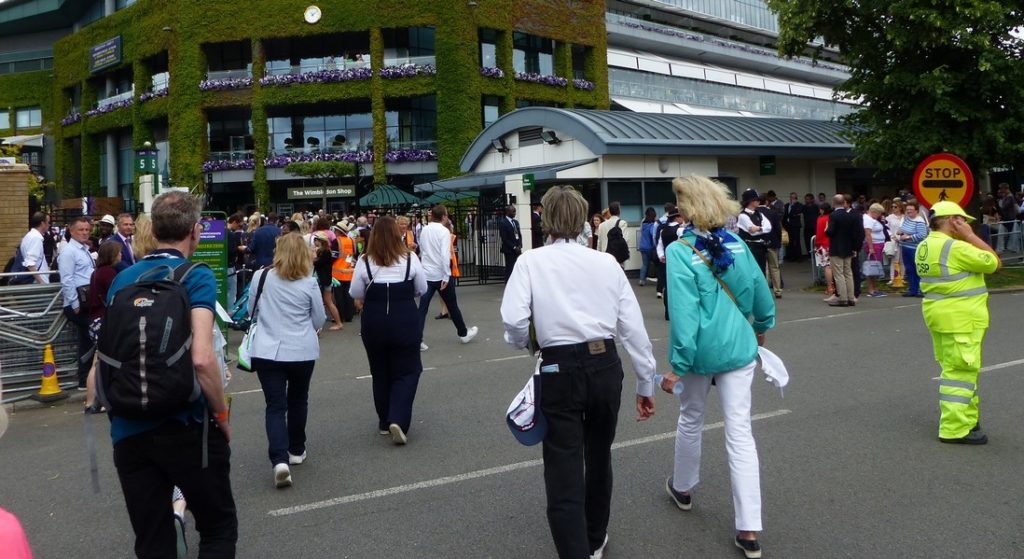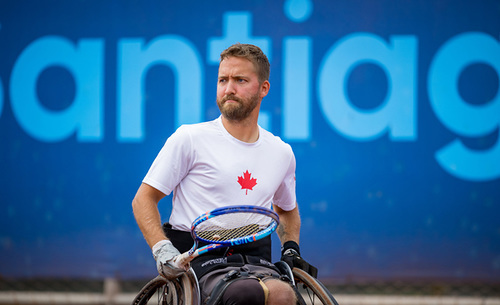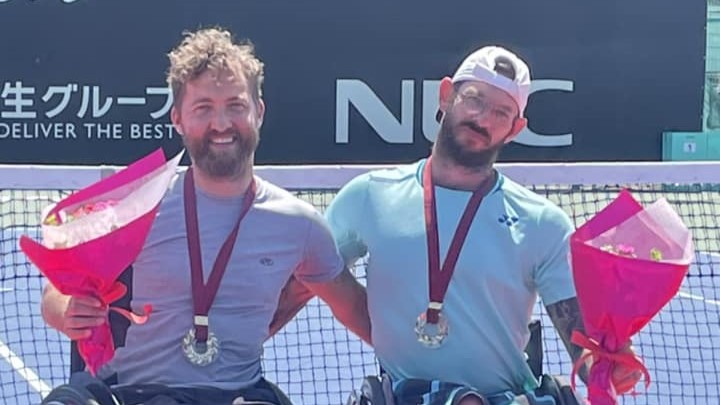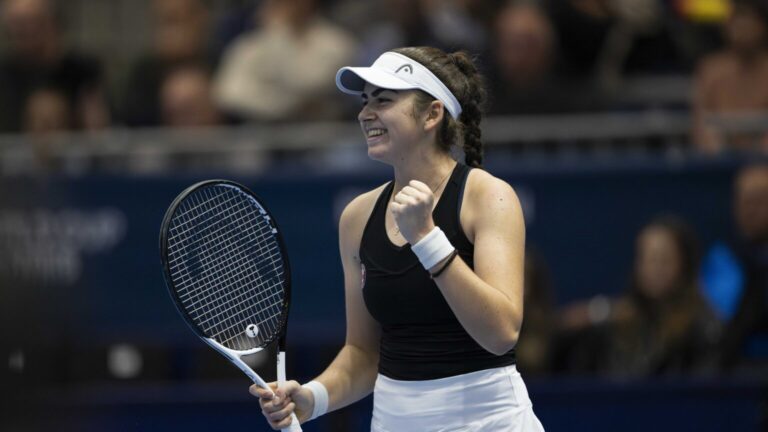
It was half an hour before the first ball was hit at Wimbledon 2017 and the people above were heading for the Gate 5 main entrance to the grounds.
They could not have known at the time – but might have suspected because Roger Federer was a betting favourite before the tournament – that the almighty Swiss was going to make history by the end of the fortnight, winning his record eighth title at the All England Club and extending his overall Grand Slam leading total to 19.
On the women’s side, there was a breakout performance by Garbiñe Muguruza as she won her second Grand Slam title (after Roland Garros 2016) by defeating five-time winner Venus Williams 7-5, 6-0 in the final to establish herself as the best of the emerging generation.
There’s no doubt Williams was deflated after the first set. Her coach David Witt told an American reporter that it was nerves but the suspicion is that it was also related to a combination of her Sjogren’s Syndrome condition, the fatigue of a 37-year-old athlete and her disappointment at failing to convert two first set points leading 5-4 that would have given her a huge psychological boost.
Instead, the 23-year-old Spaniard broke serve in the very next game and soon served out the set to effectively, as it turned out, end the competitive component of the final. The 6-foot Muguruza played impressively in all aspects of her tennis – with her ability to retrieve aggressive hitting by Williams, time after time before going on the offensive herself, being the most noteworthy.
Afterward, she talked out how many factors of her game and her overall mentality had to come together to produce the result – another Grand Slam victory. But it didn’t sound as if she was that confident she could often duplicate them so it’s up in the air as to whether she can become a really dominant player over the next few years.
Regarding Federer, he’s the paradigm of a dominant player. Even when he went from Wimbledon in 2012 until the Australian Open in January (15 majors) without a Grand Slam title, he was essentially still dominant vis a vis everyone except Novak Djokovic at his best and occasionally Rafael Nadal, Andy Murray or Stan Wawrinka.
Essentially everything has been said about the almost 36-year-old Federer’s incredible re-emergence in 2017, including his own expressions of surprise. Who could possibly have seen it coming? At the start of 2017 if anyone knew that Nadal would win his 10th Roland Garros and surpass Pete Sampras to get to 15 Grand Slam titles, who would have believed Federer could actually increase his season-starting lead over the Spaniard from three to four by winning at both Melbourne Park and London SW 19.
Federer is almost as remarkable off the court as on. One international broadcaster, who had a single question with him after he had done a couple of hours of post-final interviews on Sunday with various outlets having television rights at Wimbledon, marvelled at how thoughtful and engaging he still was despite the inevitable repetition and fatigue of interview after interview, question after question.
If there’s one criticism – and it’s probably more about those around him than himself – it’s that having a prepared T-shirt with ‘RO8ER’ on the front and a ‘19’ on the back is a little tacky and shows disrespect for his opponent in the final. Okay, wear the T-shirt for Monday’s series of post-final interviews, but self-promoting within an hour or two of the win seems unnecessarily boastful.
CANADIANS AT WIMBLEDON
MILOS RAONIC: At the start of Wimbledon, there were probably just six players who could legitimately threaten the ascendant Roger Federer over the fortnight – Novak Djokovic, Andy Murray, Rafael Nadal, Stan Wawrinka, Milos Raonic and Marin Cilic.
Ironically, all except Raonic and Nadal, upset by an inspired performance by Gilles Muller in the round-of-16, and Raonic fell by the wayside with one injury issue or another.
Roanic was beaten by Federer in the quarter-finals in a match where a service break in the fifth game of the opening set gave Federer the separation, and confidence, he needed to carry on and eventually win 6-4, 6-2, 7-6(4). It has been mentioned in this space before, but Raonic’s startling first-round loss to Thanasi Kokkinakis at the Queen’s Club pre-Wimbledon tournament – who saw the Aussie who had been out of tennis with a shoulder injury for so long pulling off that upset? – deprived him of the match play on grass that he needed. He never performed to his best during the tournament. Now No. 9 in the rankings after starting the year at No. 3, but mercifully fit, there’s an opportunity for him to make up ground in the summer hard-court season – including at Rogers Cup in Montreal (lost in quarter-finals in 2016 to Gael Monfils), Cincinnati (lost in semifinals to Andy Murray) and the US Open where he exited in the second round (Ryan Harrison) a year ago.
VASEK POSPISIL: It was a disappointment that Pospisil made the effort – playing hard-court events in Mexico and Asia and skipping the clay-court season entirely – to get his ranking high enough to get directly into Wimbledon only to come up flat – 6-4, 6-4, 6-3 – against No. 8 seed Dominic Thiem. The Austrian was going to be tough at the best of times but a subpar Pospisil had little chance.
DENIS SHAPOVALOV: The 18-year-old got a tough draw in 2013 Wimbledon semifinalist Jerzy Janowicz and played well in a 6-4, 3-6, 6-3, 7-6(2) opening-round loss. For a guy playing for the first time in the main draw at a Grand Slam event, Shapovalov didn’t look at all out of place.
GENIE BOUCHARD: Drawing No. 25 Seed Carla Suarez Navarro in the first round was certainly not ideal for Bouchard in her current form. She played well for a set but ultimately the 28-year-old Spaniard zoned in and was too good in a 1-6, 6-1, 6-1 result. Residual rust from a clay-court season right-ankle injury and its resultant lack of match play didn’t help Bouchard’s grass-court preparation. So the summer hard-court tournaments become the chance for her to re-establish herself, especially now that her ranking has fallen to a four-year low of No. 69.
FRANCOISE ABANDA: Three points from winning the second-round match against French Open champion Jelena Ostapenko, Abanda wound up losing 4-6, 7-6(4), 6-3 but made the second round of a Grand Slam for the second time in a row as a qualifier. She is now ranked a career-best No. 121 but a win over Ostapenko, an old junior rival, might have moved it high enough for her to get directly into the US Open.
BIANCA ANDREESCU: It’s hard to be critical of a just turned 17-year-old but, after qualifying, Andreescu missed a golden opportunity against No. 105-ranked Kristina Kucova in the opening round. She rushed and seemed uncomfortable playing in her first ever Grand Slam match, losing 6-4, 6-3. Probably completely capable of reversing that score the next time she plays the 27-year-old Slovak, it had to be galling for the No. 156-ranked Andreescu to see Kucova lose 6-1, 6-0 in the second round to No. 19 seed Timea Bacsinszky.
BRANSTINE QUEST ENDS
Carson Branstine was hoping to complete the third leg of the 2017 Grand Slam of junior girls doubles titles at Wimbledon. After winning both the Australian and French Opens with Bianca Andreescu, the 16-year-old from Montreal and Orange County, California, teamed up with Marta Kostyuk of Ukraine in Andreescu’s absence.
Seeded No. 1, they reached the semifinals but were beaten 6-2, 6-2 on Saturday by the American pairing of Catherine McNally and Whitney Osuigwe. Both Branstine (right knee) and Kostyuk (right arm) were a little banged up and it was simply not a good ‘chemistry’ day for them against McNally and the racquet wizardry of Osuigwe, the French Open junior champion.
McNally and Osuigwe were seeded No. 4 but failed to go on and win the final – losing 6-4, 6-3 to the unseeded duo of Olga Danilovic of Serbia and Kaja Juvan of Slovenia.
Branstine has a wild card into this week’s $25,000 National Bank Challenger ITF event in Gatineau, Quebec.
RANDOM WIMBLEDON RAMBLINGS
Rafael Nadal: With Andy Murray and Novak Djokovic being question marks because of recent form and injuries, a widespread hope at Wimbledon was that Nadal and Roger Federer would meet in the final. Despite not playing a tournament on grass after winning his record 10th French Open, Nadal looked to be playing well and was basically shot out of a cannon in the first set of his third-round win over powerful 21-year-old Russian Karen Khachanov. But he got caught in the web of the smothering, forward-moving, left-handed game of Gilles Muller and lost a heartbreaker 6-3, 6-4, 3-6, 4-6, 15-13 in the round-of-16. While it was the best men’s match of the tournament, a little bit of the spirit of this year’s Wimbledon vanished with the departure of fan-favourite Rafa. His personal disappointment was obvious in his post-match media interview – he absolutely loves Wimbledon and was genuinely gutted to see the end of another chance to win his third title.
Clash of titans: The World Cup of soccer final next year is the same day as the men’s final at Wimbledon – July 15.
The Wimbledon final starts at 2 p.m., which is 4 p.m. Moscow time.
The World Cup final starts 6 p.m. Moscow time – so that could possibly be right when the Wimbledon final is getting into its meatiest part, as long as it’s a little more competitive than this year’s one hour and 41-minute Federer-Cilic match.
The two World Cup semifinals start at 9 p.m. Moscow time, so the 6 p.m. start for the final is a little odd. Apparently World Cup organizers are unwilling to change their start time. What are the chances that the All England Club, which used to promote the start time for the final as “2 p.m. precisely” would alter its start time? Highly unlikely, but stranger things have happened.
Kim Clijsters: The 34-year-old Belgian was highly visible at Wimbledon this year – coaching compatriot Yanina Wickmayer, playing in the “ladies invitation doubles” event and doing match commentary on the BBC. And, not surprisingly, being her customary sunny self as can be seen in this picture from the practice courts on the middle Sunday.
Mandy Minella: The 31-year-old from Luxembourg competed in the Wimbledon singles – losing 6-1, 6-1 in the first round to Francesca Schiavone – while four months pregnant. Minella said afterward, “I want to compete again at Wimbledon in 2018 – and bring the baby buggy.”
Ranked No. 82, she received 35,000 British pounds (close to $49,000 US) for appearing in the first round – a sum that should help at least cover the cost of a baby buggy, toys and diapers for her first born.
LONDON POST CARD
The Notting Hill Gate underground station in London is one of the city’s most distinctive with its brickwork construction. This couple were having an animated chat in a little alcove on the station platform last Sunday morning.










